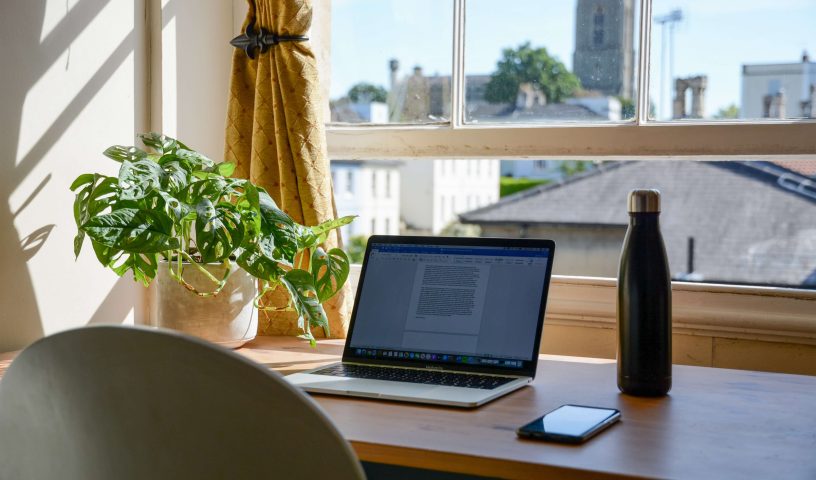
Since the COVID-19 pandemic started, many American workers have been spending a lot more time at home. In fact, according to the American Time Use Survey, conducted by the Bureau of Labor Statistics, the percentage of employed persons working at home on days they worked nearly doubled, rising from 22 percent in 2019 to 42 percent in 2020.1
Now in 2021, working from home is a daily reality for many companies, especially early-stage startups that may not yet have a dedicated office space or those that have a fully remote workforce. If they’re able to, many remote and hybrid workers are looking to upgrade their current home setups from a folding table and a kitchen chair in their bedroom, to a fully equipped home office that is as functional as it is comfortable.
1. Considerations
When selecting a space for your office, consider:
- Electric – Computers, monitors, printers, and nearly every piece of hardware that makes remote work possible requires some form of electronic equipment. Make sure your space has plenty of outlets.
- Lighting – Ideally, the location of your home office will have a window or two for some much-needed sunlight.
- Privacy – The ideal home office space will have some form of privacy from pets, kids, and other distractions and some form of quietness. This privacy will encourage focus and be a more pleasant space to spend time in.
- Clear Division – Virtual fatigue is a phenomenon that has been sweeping American workers since the onset of the pandemic. Besides the psychological nature of human contact through a laptop partition, many remote or hybrid workers are having a hard time “unplugging” from work. Choose an area that you can clearly define as a “working area” and do your best to avoid that area when you’re not working.
2. Select Your Space
The location of your home office will largely depend on the space you have available to you. Some remote workers will repurpose a space entirely while others prefer to update their space to be multi-functional.
- Additional rooms: In most cases, additional rooms will already be equipped with an electrical system, windows, and lighting, making them a good choice for retrofitting into an office.
- Basement rooms: A popular choice among remote employees, as they can create a clear separation between work and leisure areas. However, basements can sometimes pose problems with lighting and temperature.
- Closets: In small homes and apartments, unused closets can be converted into built-in offices or, “Cloffices”.
- Partitioned areas of larger rooms: If you have a large, open living room or bedroom, it might be an option to use a room divider to section off part of the space for use as an office.
3. Choose the Furniture
There is a massive array of features, materials, and price points in furniture. Think about your needs and what will work for your budget. There are some standard items that your home office should have:
- Desk –The desk you choose deserves careful consideration. When deciding on which desk to buy, take stock of your wants and needs. How many monitors do you use? Do you need drawers or additional storage? Do you want an adjustable standing desk, which provides a plethora of health benefits? Do you want something modern? Something rustic?
- Office Chair – The average American employee sits anywhere from 6.5 hours to 10 hours a day. Given the time spent in a chair, consider investing in an ergonomic chair that is supportive and helps maintain a healthy posture.
- Storage Cabinets – Although many entrepreneurs in the health care startup space have embraced going paperless, there is still a want and a need for all things paper. A filing cabinet can not only give your office a more polished and professional look but can also help you stay organized.
- Accent Tables & Chairs – Although you may not have many visitors at your home office, it never hurts to have an extra chair or two as well as a small accent table where you can take meetings and replicate moving around the office.
4. Optimize Your Tech Stack
After you set a budget for your home office tech, you can build a modern marvel that will “wow” your colleagues, investors, friends, and family. Like choosing furniture, assess all your technological needs.
- Laptop – If not provided with one, you can choose from one of many different reliable laptops currently on the market. Evaluate processing power, screen resolution, and screen size.
- Laptop Stand – If you’re not using a standing desk, using a laptop stand (or box) to elevate your laptop to eye level will help prevent poor posture and keep you on task.
- Monitor – If one screen isn’t enough for your line of work, consider investing in one or more additional monitors.
- Printer – Whether it’s just a basic printer or feature-rich printer that can print images on top of your morning latte (yes, that does exist), a printer is typically a must-have for your home office.
- Noise-canceling headphones – Noise-canceling headphones aren’t just for your developer friends. A good pair of noise-canceling headphones can come in handy if you live in an area with a lot of activity and distractions.
- Mouse and Keyboard – Adding a wireless mouse and keyboard to your current tech setup can improve your comfort and increase productivity.
- Wire Management – There are few things worse than having to move a monitor only to have an HDMI cord or power cord get tangled up in a bird’s nest made of wires. Zip ties, modesty panels, and cable clips can save you time and headaches.
5. Add Some Ambience
Depending on your role, you may be working from your home office a couple of days a week, or you may be working from it daily. Adding ambiance to your space can really help you dial in.
- Paint Color – Paint is one of the easiest ways to refresh a room or tie everything together. In fact, there is some research on the effect colors can have on our productivity and our mood. Choose an energizing but not an overwhelming color for your space.
- Plants – Consider adding a couple of low-maintenance house plants to add a bit of greenery to your space. Plants such as dracaena, snake plant, parlor palm, and Boston fern are all easy to take care of, can increase productivity, and are known for their air filtering nature.
- Personal Touches – Finally, don’t forget to add your own personal touches to your space. After all, it is your space. Be sure to add photos of your kids, pets, your favorite wall art, and anything in between.
Whether you’re an entrepreneur without a dedicated office, a hybrid employee, or a fully remote employee, taking some time and spending some money to revamp or build your best home office will pay dividends in your mood and your productivity.
For more tips on how to run a successful startup and to become a leader in the field, browse our blog and follow us on Twitter and LinkedIn.
1 – U.S. Department of Labor. (2021, July 22). American Time Use Survey. Bureau of Labor Statistics. Retrieved September 22, 2021, from https://www.bls.gov/news.release/pdf/atus.pdf.


